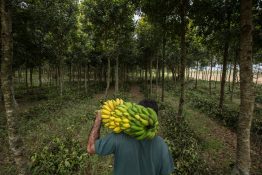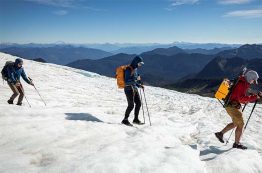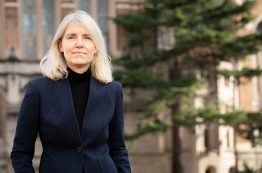Farmers struggling to adapt to rising temperatures in tropical regions can unleash the benefits of natural cooling, alongside a host of other wins, simply by dotting more trees across their pasturelands. For the first time, a study led by the University of Washington puts tangible numbers to the cooling effects of this practice. Researchers at the UW and The Nature Conservancy, along with Duke University, the University of California San Diego and Stony Brook University Hospital, find that adding trees to pastureland, technically known as silvopasture, can cool local temperatures by up to 2.4 C (4.3 F) for every 10 metric tons of woody material added per hectare (about 4 tons per acre) depending on the density of trees, while also delivering a range of other benefits for humans and wildlife.
Read more at UW News »This tiny coastal fish wears a toothy coat of armor
The ocean is full of otherworldly creatures, seemingly from alien planets with alien capabilities. In most cases, the award for craziest looking critter would go to an invertebrate. But many fish are contenders, too, and there’s an oddly adorable one common in northwest waters. What does it look like? Imagine a golf ball. Now put some googly eyes on it and add a suction cup to its belly.
Read more »Glaciers are squishy, holding slightly more ice than thought
Glacier ice is usually thought of as brittle. You can drill a hole in an ice sheet, like into a rock, and glaciers crack and calve, leaving behind vertical ice cliffs. But new University of Washington research shows that glaciers are also slightly compressible, or squishy. This compression over the huge expanse of an ice sheet — like Antarctica or Greenland — makes the overall ice sheet more dense and lowers the surface by tens of feet compared to what would otherwise be expected, according to results published Jan.
Read more at UW News »UW Environment scientist named 2021 AAAS fellow
Emily Carrington, resident scientist at the UW’s Friday Harbor Laboratories, was named a AAAS Fellow, according to a Jan. 26 announcement by the American Association for the Advancement of Science. She is among 564 new fellows from around the world elected in 2021, who are recognized for “their scientifically and socially distinguished achievements” in science and engineering. Carrington is honored for her research contributions in biomechanics and ecophysiology, as well as efforts to promote diversity and inclusion in science.
Read more at UW News »In conversation with Dean Maya Tolstoy
Earlier this month, marine geophysicist Maya Tolstoy joined the University of Washington as the Maggie Walker Dean of the College of the Environment. Over her more than 30-year career as a researcher, professor and administrator, Dean Tolstoy has dedicated herself to furthering our understanding of the fundamental processes of our planet and advancing diversity, equity and inclusion in academia. The College welcomes its new dean at a pivotal time, when the impacts of the climate crisis are growing more visible each year and the need for equity and justice in our field is clearer than ever.
Read more »





